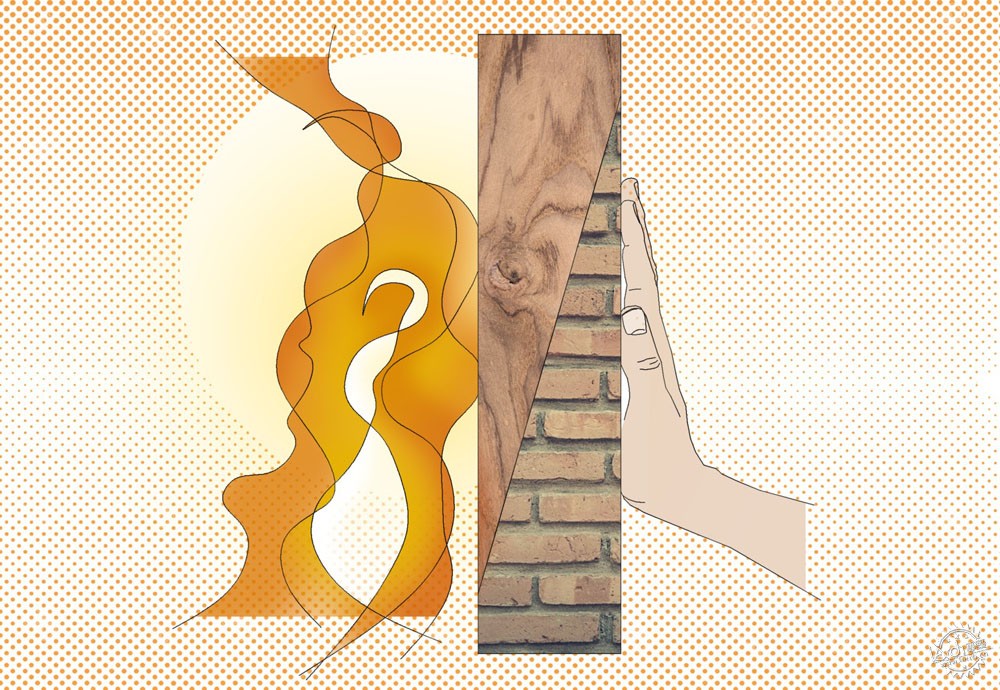
反应力与耐火性:火灾中的材料分类
Reaction And Fire Resistance: How Are Materials Classified In The Event Of A Fire?
由专筑网李韧,王雪纯编译
在火灾发生的时候,保护人们的生命是最重要的命题。建筑都应该保证能够及时疏散人群,但是疏散的时间很大程度上取决于建筑材料的使用。
为了优化这一过程,欧盟在2000年采用了EN 13501标准[1],其中规定了一系列不同材料的防火性能等级。其分类以同样的测试方法为标准,而后再进行比较,这已经成为多个国家的使用参考。
由于建筑师在项目中需要对材料进行选择,因此我们编写了一些专业术语,让人们更好地了解建筑材料的安全等级。
火灾反应力
根据材料对于火灾的反应,可以被分为7种不同的等级。要理解其中的区别,首先要了解突发性火灾,意思是与原始材料无关的火灾,这种火灾会迅速提升室内的温度,同时快速传播。[2]
A1类材料不会燃烧,也不会引发火灾,例如混凝土、玻璃、钢材、天然石材、砖块、陶瓷等等。
In case of fire, protecting the lives of people is the most important. All occupants of the building should have the opportunity to evacuate on time, and the time available depends largely on the materials chosen and their behavior during fire exposure.
In order to facilitate and optimize this process, the European Union has adopted the Standard EN 13501 [1], introduced in the 2000s, which specifies a series of classes that determines the anti-fire properties of different materials. Their classifications are unified and compared based on the same test methods, and are currently used as a reference in many countries around the world.
Because of the architect’s role in choosing materials for projects, we have compiled the most important nomenclature to better understand the level of security of our built environment.
Reaction to Fire
Materials and products can be classified into 7 different Euroclasses according to the way they react to fire. To understand this classification, it is important to consider the generalized sudden combustion or flashover, which is the moment when combustible materials that were not involved in the original fire begin to burn, increasing the temperature in the room and increasing its speed of propagation. [2]
A1
It does not fuel and does not contribute to the fire. Among them we can find concrete, glass, steel, natural stone, bricks, and ceramic materials and products.

A2类材料可燃性低,不易引发突发性火灾。其中有类似于A1等级的材料,但是其中有小比例的有机材料。
A2
Little fuel and very low contribution to the fire, without causing flashover. Among them we can find materials and products similar to the Euroclass A1, but with a small percentage of organic components.

B
含有很少燃料,造成火灾的概率低,但是会引起突发火灾。其中包含石膏板与防火木材。
Little fuel and very low contribution to the fire, but they cause flashover. Among them we can find materials and products such as gypsum boards and some woods with fire protection.

C
具有可燃性材料,能够在10分钟内引起突发性火灾。其中包括酚醛泡沫,以及有着较厚表面覆层的石膏板。
Fuel, causes flashover at 10 minutes. Among them we can find materials and products such as phenolic foam, or gypsum boards with thicker surface coatings.

D
可燃材料,引发火灾的时间不到10分钟。其中包括没有保护层的木材,其火灾反应力与其厚度与密度有关。
Fuel, causes flashover before 10 minutes. Among them we can find materials and wood products without protection, varying their reaction according to their thickness and density.

E
可燃材料,引发火灾的时间不到2分钟。其中包括低密度纤维板、复合绝缘塑料。
Fuel, causes flashover before 2 minutes. Among them we can find materials and products such as low density fibreboard, or plastic composite insulation systems.

F
这一类产品无法明确定义,主要为未经测试的材料与产品。
Indeterminate behavior. Materials and products not tested.

S
S意为烟雾不透明性,即不会产生烟雾的元素能力。可细分为:
S1:低透明度、可产生烟雾;
S2:中等透明度、可产生烟雾;
S3:高透明度、可产生烟雾。
D
可燃颗粒,该元素既不会产生滴落物,也不会构成燃烧颗粒。可细分为:
D0:产生滴落物或颗粒;
D1:产生滴落物或非燃烧颗粒;
D2:产生滴落物或燃烧颗粒。
耐火性
每个施工元素在面对火灾时都有不同的反应,其耐火性能由以下参数来确定。此分类通过数字来表述,单位为“分钟”,其中有数字15、30、45、60、90、120、180、240、360等。[2]举例来说,REI 90说明了建筑元素在90分钟内所保持的稳定性(R)、完整性(E)、隔热性(I)。
R
稳定能力。材料的稳定性意思是在不损坏结构特性的前提下的机械化抵抗力。由于施工策略和材料的承重不同,它们的性能也不同,但是在这些情况下,都需要明确其形变率及最大变形程度。
E
完整性。建筑元素放止火焰与热气进入未受灾区域的能力。
I
隔热性。建筑元素在没有直接面对火灾时,阻止温度升高的能力。
Smoke Opacity. The ability of the element to not produce fumes. It's divided into:
S1. Low opacity and smoke production.
S2. Medium opacity and smoke production.
S3. High opacity and smoke production.
D
Flaming Droplets/Particles. The element's ability to produce neither droplets nor inflamed particles. It's divided into:
D0. Produces drops or particles.
D1. Produces drops and/or non-inflamed particles.
D2. Produces drops and/or inflamed particles.
Fire Resistance
Each constructive element behaves differently when coming into contact with fire, and its resistance is measured based on the following parameters (or their combinations). This classification is usually accompanied by a number (in minutes: 15, 30, 45, 60, 90, 120, 180, 240 or 360) that indicates the time in which these parameters are met. [2] By way of example, an REI 90 indicates that a constructive element maintains its stability (R), integrity (E) and its thermal insulation (I) for 90 minutes.
R
Supporting Capacity. Capacity of the constructive element to resist mechanically, without losing its structural properties. Although performance criteria vary according to the constructive solution and the loads they receive - axial (such as walls or pillars) or in flexion (as floors or beams) - in both cases their deformation rate and maximum deformation are measured.
E
Integrity. Capacity of the construction element to prevent the passage of fire and hot gases into an area not affected by the fire.
I
Isolation. Capacity of the constructive element to prevent the temperature increase in the face not directly exposed to the fire.

W - M - C – K
这里还有一些需要参考的其他参数:
- W(辐射):由于各个元素的热辐射,建筑元素将火传递到其他未受影响的房间的能力;
- M(机械行为):由于其他周围部件的结构性损毁,建筑元素所具有的抗影响能力;
- C(自动闭合):在没有人为操作的前提下,门窗自动关闭的能力;
- K(防火涂层):一般指墙体与天花板的防火涂层,这能够成为构件的防护层。
以上术语能够以最简单的方式让人们了解了防火材料的等级,但是材料的等级必须通过当地专业人员进行全面评估。
图片:Cortesía de ArchDaily
W - M - C – K
Other important parameters to consider:
- W (Radiation). The ability of the element to prevent the transmission of fire to an unaffected room, due to excess heat radiated through the element.
- M (Mechanical action). The ability of the element to resist the impact due to the structural failure of another nearby element.
- C (Automatic closing). Capacity of doors and windows to close completely without human intervention.
- K (Protection against fires of coatings). The ability of wall and ceiling coatings to provide protection to the components behind them.
The terms and standards referred to above offer a simple introduction to fire protection via one of the most esteemed standards in the world. It is important to clarify that this is a serious issue which must always be evaluated by experts who are knowledgeable about local regulations and the technical specifications of each material and product used.
注释:
[1] UNE-EN 13501-1:2007+A1:施工产品与建筑元素的防火等级.第一部分:通过火灾反应测试的数据分类
[2] 案例参考:InnoFireWood. (2019). EUROCLASS System. 4月, 2019, Virtual.vtt.fi.
网站:
http://virtual.vtt.fi/virtual/innofirewood/stateoftheart/database/euroclass/euroclass.html
参考:耐火等级.4月, 2019,瑞典RISE研究机构.
网站:
https://www.sp.se/en/index/services/fire_classes/sidor/default.aspx
[1] UNE-EN 13501-1:2007+A1: Fire classification of construction products and building elements. Part 1: Classification using data from reaction to fire tests.
[2] Examples Reference: InnoFireWood. (2019). EUROCLASS System. April, 2019, by Virtual.vtt.fi.
Website: http://virtual.vtt.fi/virtual/innofirewood/stateoftheart/database/euroclass/euroclass.html
Reference: Fire resistance classes. April, 2019, by RISE Research Institutes of Sweden. Website: https://www.sp.se/en/index/services/fire_classes/sidor/default.aspx
|
|
